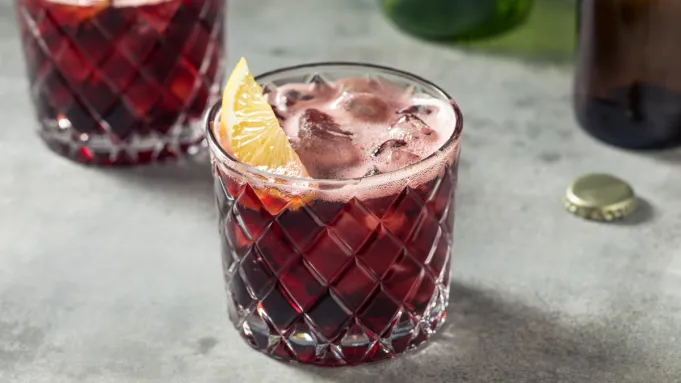
Ah, the Kalimotxo. What can be said about the Kalimotxo that hasn’t been pretentiously asserted by an undergraduate who just learned about it?
The Kalimotxo (sometimes spelled “Calimocho” and pronounced cah-lee-mo-cho) is the seemingly unlikely combination of red wine and Coca-cola, and is a very Spanish drink. It’s more Spanish than the Adonis (which uses Spanish sherry), more than the Carajillo (which started in Spain but is more Mexican now), and more Spanish than the Spanish Coffee (which isn’t even a little Spanish). It’s even more Spanish than the Gin & Tonic, which is English by way of India but has been adopted by Spain the way that the jungle adopted Tarzan.
The reason it’s more Spanish than these others is that the Kalimotxo is a drink that is really only ever found in Spain, and then, only by a certain subset of usually young people and students—serious bartenders, of which Spain has many, will “start throwing tomatoes and stones at you” if you ask for one. It’s never been taken up by the global cocktail community, and by and large, if you’ve heard of one, it’s because you’re either from Spain, spent time there, or spent time around someone who did. I personally first heard of it in college, where a newly sprouted affection for Kalimotxos was paraded around almost like a liquid advertisement of someone’s travels, conspicuously ordered and conspicuously enjoyed, mostly because it’s in bad taste to simply wear a hat that says “I studied abroad in Barcelona.”
But there’s something more to the Kalimotxo, something that seems to be immune to sophomoric tedium or mixological condescension, something that keeps people going back decade after decade. As we’ve seen with so many other ostensibly ignorable drinks like the Bronx or the Harvey Wallbanger, any cocktail that stays popular for this long is worth consideration, and when you actually try it—actually mix together a roughly equal measure of cheap wine and Coke, put over ice with a squeeze of lemon—I’d be willing to bet your first sip would be met with surprise, if not delight.
The Kalimotxo, as best we can tell, comes to us from 1972, when a couple young Spaniards in the Basque town of Algorta were planning an event discovered and discovered the wine they had sourced was nearly undrinkable, and tried to salvage it by introducing the sweet, sour, and spice of Coca-Cola classic. They initially called it the Roja Libre or Cuba Libre del Pobre (literally the “Poor Man’s Rum and Coke”) before naming it for themselves, but that early name is a helpful guide to how to think about it, as are the circumstances of its invention.
The Kalimotxo is not for that nice bottle of Burgundy you picked up for the weekend. The Kalimotxo is for wine that is old, or cheap, or otherwise just lying around. In Spain (as in Trader Joe’s), wine is cheap and abundant, and the cheap wine tends to be incomplex, minimally oaked, fruity, and dry. These are wines for which it’s not some holy crime to adjust in the name of something more enjoyable, and for which a measure of Coca-Cola can prove delightful. The wine has notes of red fruit that Coke loves (see: Cherry Coke) and the Coke and ice provide the same spice, acid, and refreshing dilution that makes Sangria work so well.
It’s honestly worth having just to see what it’s like—who knows, you just might, as so many have, find it to be a charming treat, a perfect midweek use for that half-bottle you opened on the weekend that is past its prime but seems a shame to throw away. Continue to enjoy through all seasons or moods,, at least until you hear yourself at a party beginning to correct a stranger’s pronunciation of “Barthhelona,” at which point it might be best to throttle back.
Kalimotxo
- 4 oz. dry red wine
- 3 oz. Coca-Cola Classic
- Squeeze of lemon (~⅛ to ¼ oz. lemon juice)
Combine all over ice in a glass. Throw the lemon in there if you want to. Drink and enjoy.
NOTES ON INGREDIENTS

Elena Noviello/Getty
Ratios: I liked this more with a little more wine than coke. It’s against the spirit of the Kalimotxo to measure it out, but the bartender in me can’t help himself. Feel free to eye-ball it.
Wine: You want a wine that’s dry (i.e. not sweet), cheap, and unimpressive. It’s not just the money, either—when there’s too much oak or too much fruit, it tends to work against the drink. To be clear, you really can’t ruin a Kalimotxo with your wine choice, but the best are the inexpensive and incomplex reds from Spain or Italy.
Citrus: Some people call for it, some don’t. I think it needs it—otherwise the finish is a little cloying. If you were in the hot sun on a Spanish terraza, you probably wouldn’t mind, but in your kitchen is another story. Cut up a lemon and squeeze a wedge into there. Lime also works, but not as well.
Other Ingredients: A few recipes you’ll find invite you to add orange juice or pomegranate and those are all pretty good, but at some point you’re just making Sangria. The charm of Kalimotxos is that they’re dead easy, and when you start fussing over it, you’re really starting to make something else.
Authors
-

Jason O’Bryan
Jason O’Bryan has set up a professional life at the intersection of writing and cocktails. He’s been managing cocktail bars for the last twelve years, first in Boston and now in San Diego, where he’s…
instagram:
Error: No feed with the ID 1 found.
Please go to the Instagram Feed settings page to create a feed.









